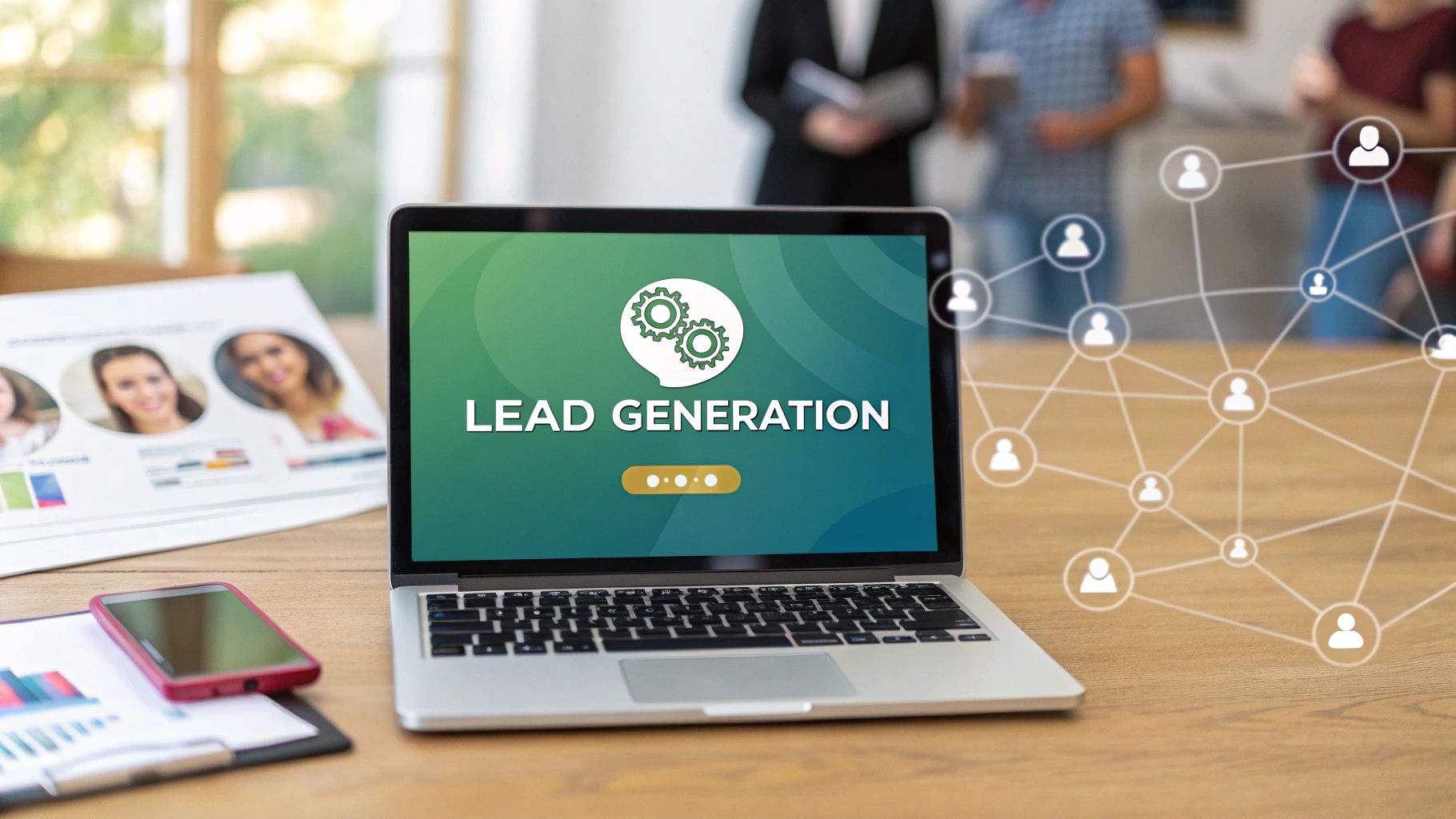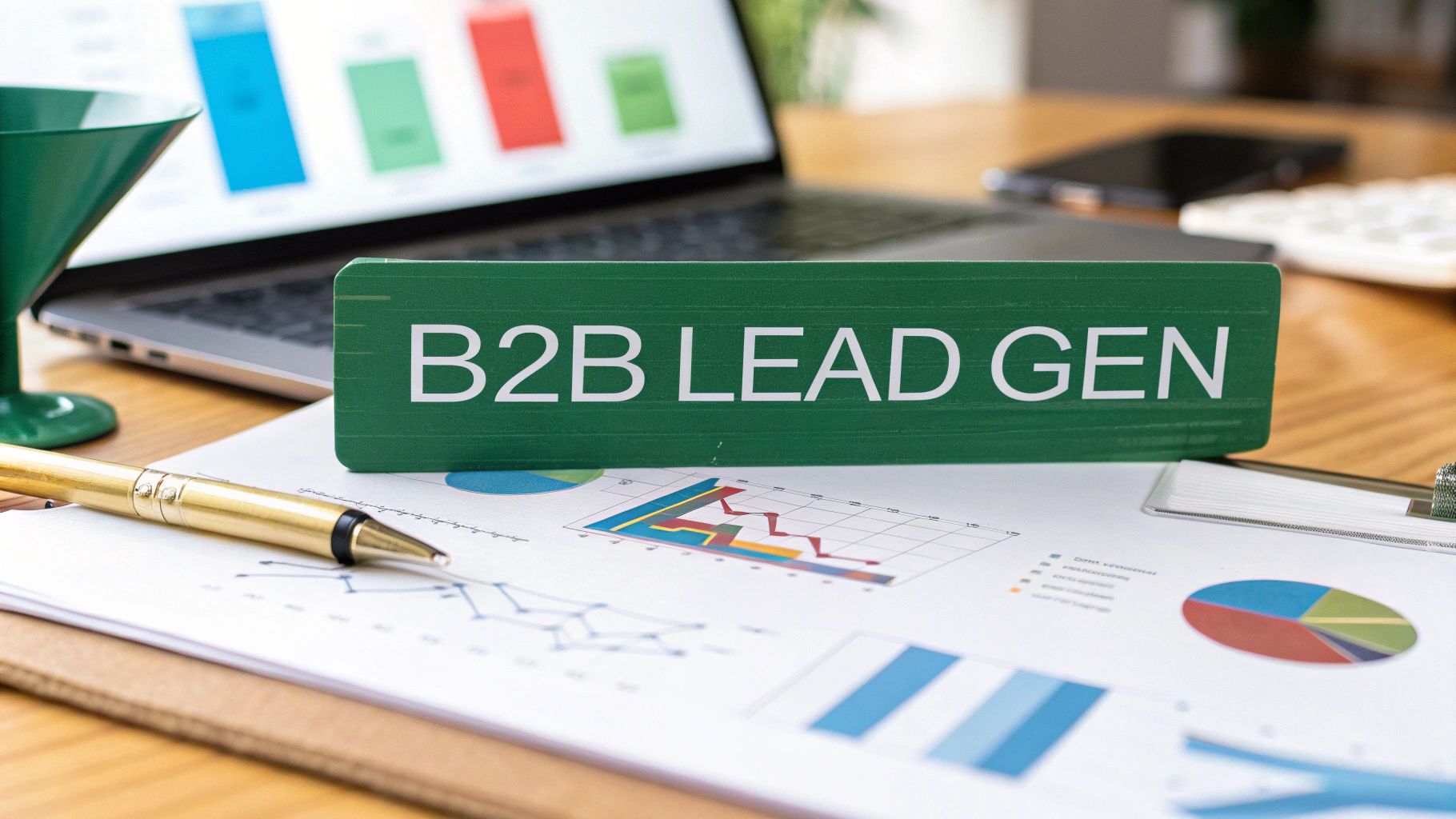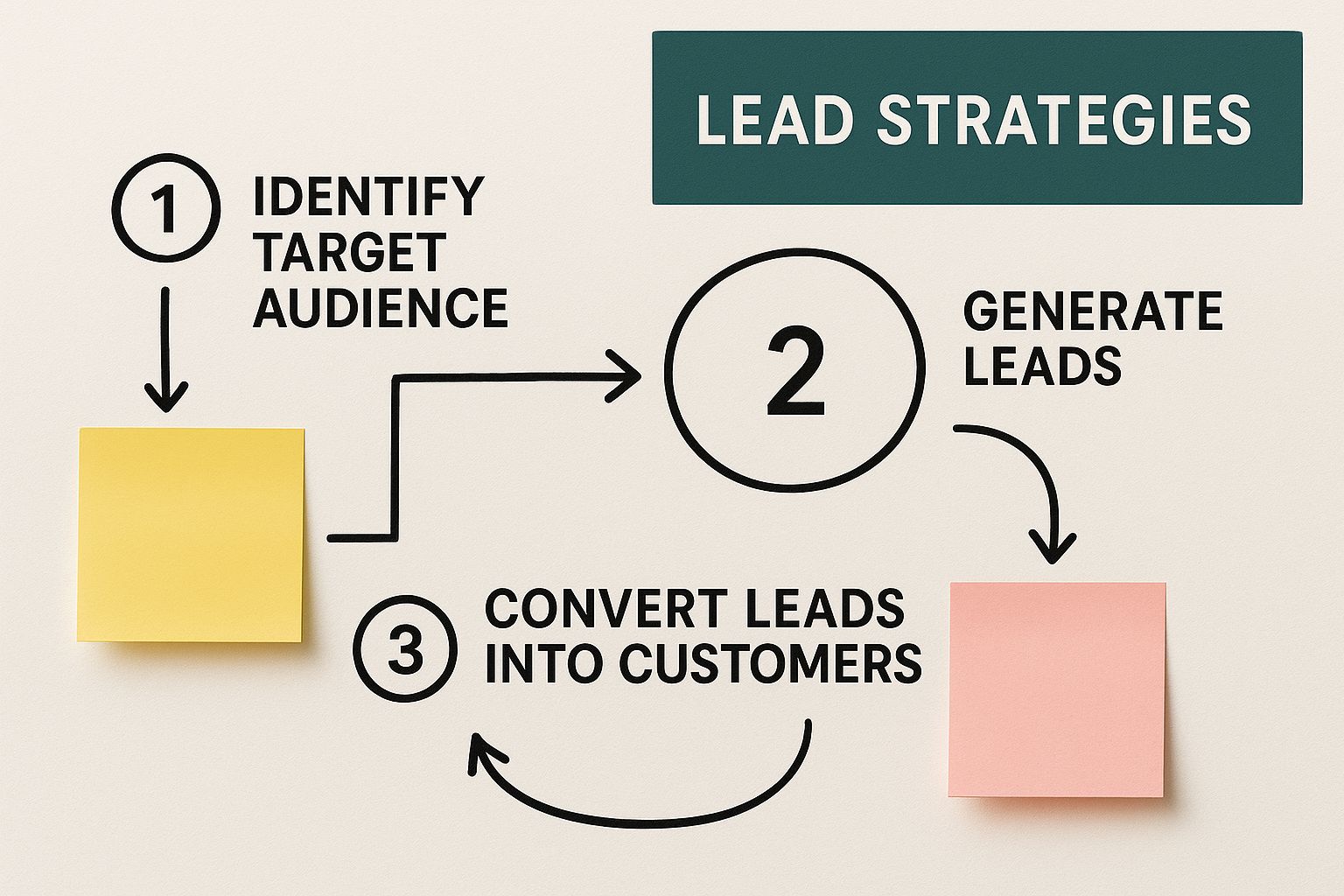In today's competitive market, a steady stream of qualified leads is the lifeblood of any growing business. Simply casting a wide net and hoping for the best is an outdated strategy that wastes time and resources. The real challenge lies in consistently attracting the right prospects, engaging them effectively, and guiding them through a seamless conversion process. A haphazard approach leads to an unpredictable pipeline and leaves sales teams scrambling to meet their targets.
This guide provides a definitive blueprint to overcome that challenge. We have compiled 10 essential lead generation best practices designed to build a robust and sustainable sales pipeline. Forget generic advice; we are diving deep into actionable strategies that deliver tangible results. From creating compelling lead magnets and mastering SEO to implementing sophisticated account-based marketing and leveraging automation, each point is a critical component of a modern growth engine.
Throughout this comprehensive listicle, we will provide practical steps, real-world examples, and specific tool recommendations to help you execute these tactics flawlessly. You'll learn how to optimize every touchpoint in your outreach, ensuring your efforts are both efficient and effective. We will also explore how tools like EmailScout can be integrated to precisely target and connect with the key decision-makers who can truly move the needle for your business. Let's explore the foundational strategies that will fill your pipeline and drive revenue growth.
1. Content Marketing and Lead Magnets
Content marketing is the strategic foundation of modern lead generation, and lead magnets are its most powerful tool. Instead of directly asking for a sale, this approach focuses on providing genuine value upfront. By creating and offering high-quality, relevant resources like eBooks, whitepapers, or checklists, you attract potential customers who are actively seeking solutions to their problems.
This method shifts the dynamic from an interruption to a welcome exchange. Prospects willingly provide their contact information, such as an email address, in return for content that helps them. This not only generates a lead but also positions your brand as a credible, trustworthy authority in your industry. It's a fundamental strategy for building an audience and nurturing relationships over time, making it one of the most effective lead generation best practices available.
How to Implement This Strategy
Implementing a lead magnet strategy involves more than just creating a PDF. It requires a thoughtful, user-centric approach.
- Identify a Core Problem: Pinpoint a specific, urgent pain point your target audience faces. Your lead magnet should offer a direct, actionable solution to this single problem.
- Create High-Value Content: Develop a resource that is genuinely useful. Companies like HubSpot excel at this by offering comprehensive marketing templates and guides that users can immediately apply to their work.
- Design Compelling Landing Pages: Create a dedicated, distraction-free landing page for your lead magnet. Use a clear call-to-action (CTA) and a simple form to maximize conversions.
- Promote Across Channels: Share your lead magnet on social media, in your email newsletter, through blog posts, and even via paid advertising to reach the widest possible audience.
- Nurture New Leads: Once someone downloads your resource, don't stop there. Follow up with a targeted email nurture sequence that provides additional value and guides them further down the sales funnel.
The following infographic highlights key data points on the effectiveness of well-executed lead magnets.
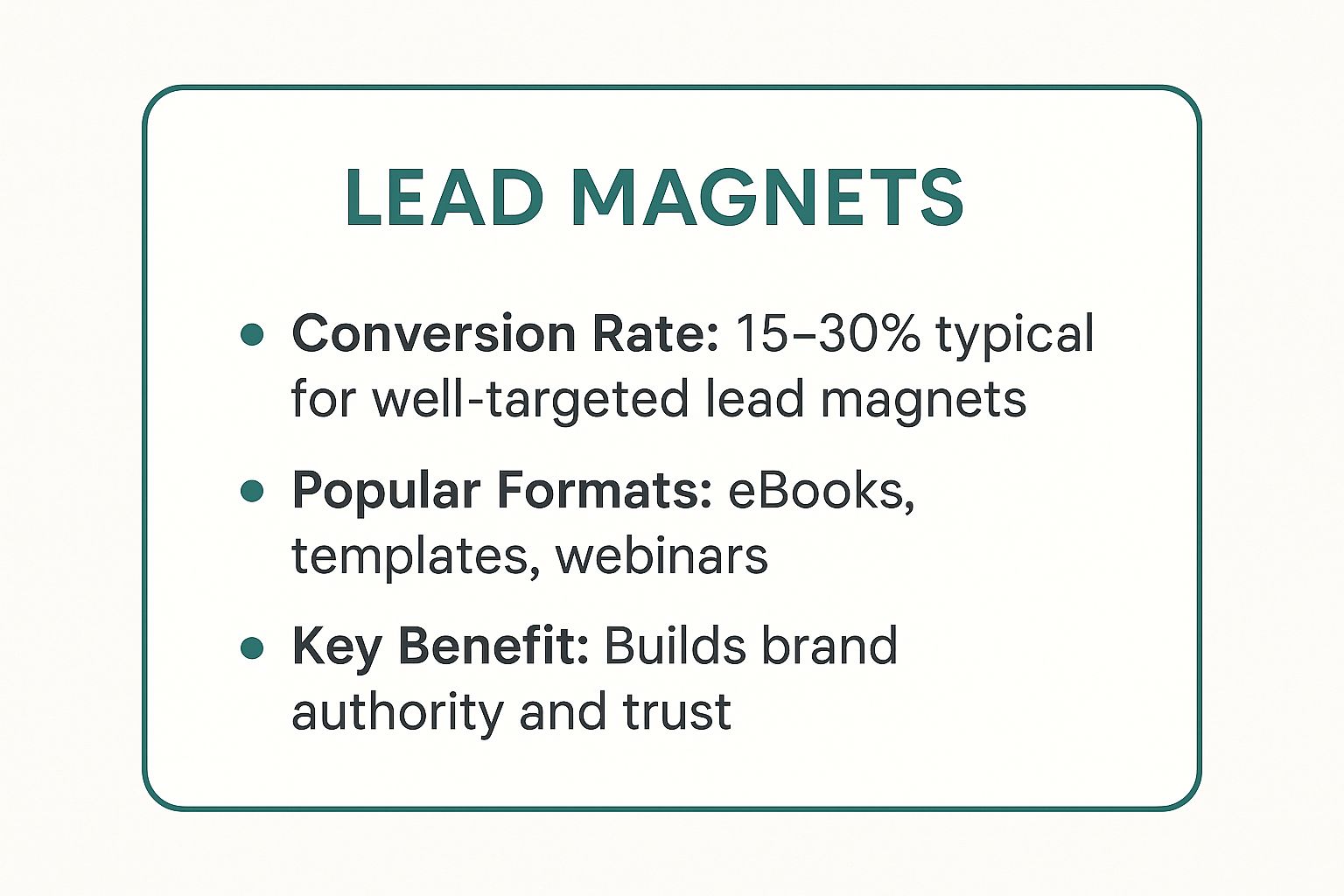
As the data shows, a highly targeted lead magnet can achieve impressive conversion rates while simultaneously building brand authority. This combination makes it an indispensable tactic for sustainable growth.
2. Search Engine Optimization (SEO) for Lead Generation
Search Engine Optimization (SEO) is a powerful, long-term strategy that turns your website into a passive lead generation engine. It involves optimizing your site and content to rank highly in search engine results for keywords your ideal customers are using. This organic approach attracts high-intent prospects who are actively seeking answers and solutions that your business provides.
Unlike paid advertising, SEO captures leads at every stage of the buyer's journey, from initial awareness to the final decision. By consistently appearing as the solution to their queries, you build immense credibility and trust. This makes SEO one of the most sustainable and cost-effective lead generation best practices for building a predictable pipeline of inbound inquiries.
How to Implement This Strategy
A successful SEO strategy requires a systematic approach that aligns content with user intent and technical performance. It's about more than just keywords; it's about creating a comprehensive user experience.
- Target High-Intent Keywords: Focus on long-tail keywords that signal a user is close to making a purchase or inquiry, such as "best CRM software for small business" instead of just "CRM."
- Create Topic Clusters: Build your authority by developing comprehensive content hubs around your core services. For example, Ahrefs creates extensive educational content covering all aspects of SEO, naturally attracting their target audience.
- Optimize for Local Search: If you serve a specific geographic area, optimize your Google Business Profile and create location-specific pages to attract local customers actively searching for your services.
- Embed Clear CTAs: Every piece of optimized content, from blog posts to service pages, must have a clear and relevant call-to-action (CTA) that guides the visitor on what to do next, like "Request a Demo" or "Download Our Guide."
- Prioritize Technical Health: Ensure your website has fast page load speeds, is mobile-friendly, and has a logical structure. A poor user experience can negate even the best content efforts.
3. Social Media Lead Generation
Social media lead generation leverages platforms like LinkedIn, Facebook, and Instagram to identify and convert prospects where they actively spend their time. This strategy moves beyond simple brand awareness, using a mix of organic content, paid advertising, and direct engagement to capture leads directly within the platform.
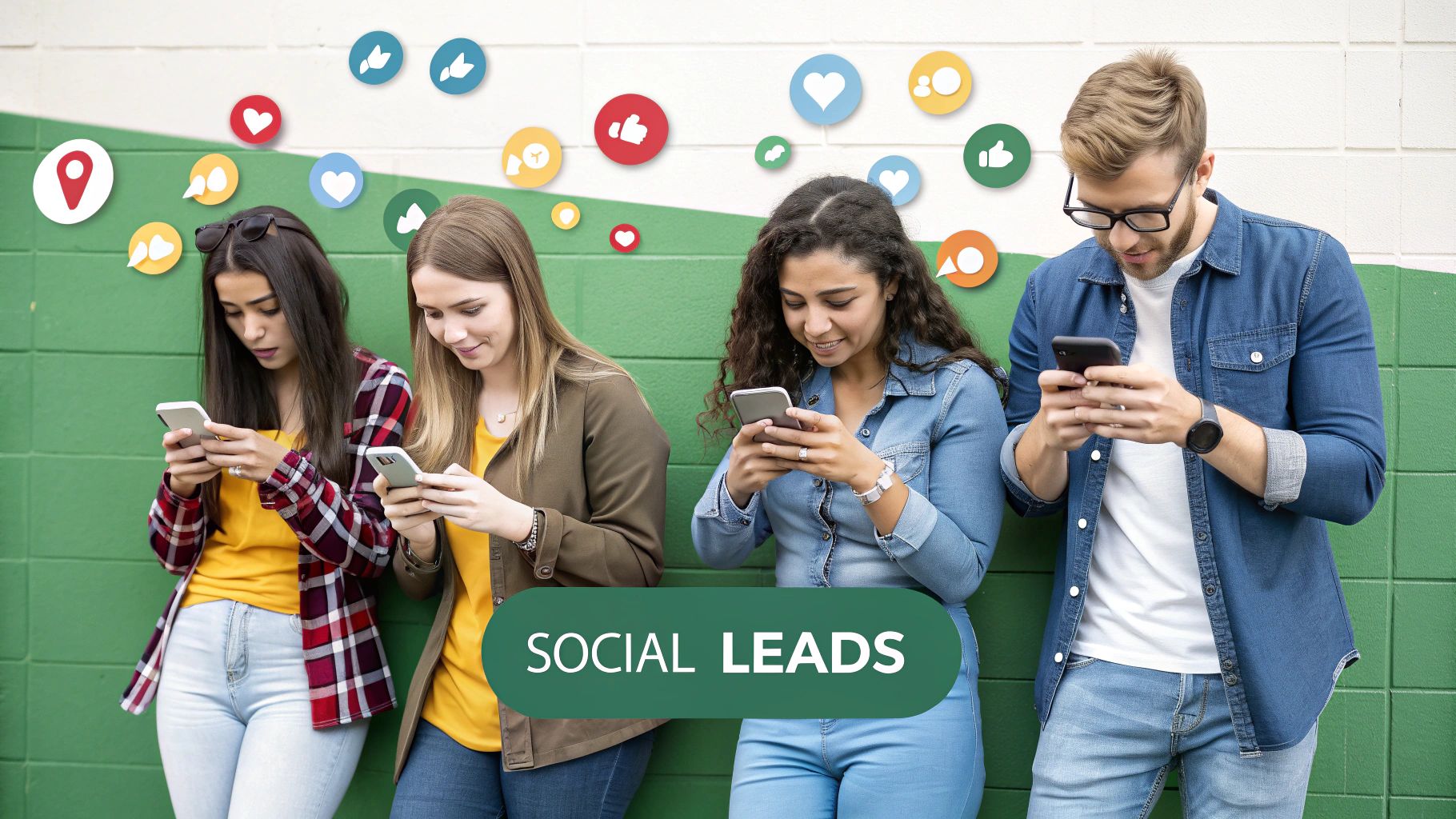
This approach is effective because it meets customers in a familiar, low-friction environment. Instead of directing them off-site, you can use features like Facebook Lead Ads or LinkedIn's lead gen forms to collect their information seamlessly. This makes it an essential part of modern lead generation best practices, allowing you to build a community, generate leads, and nurture relationships simultaneously.
How to Implement This Strategy
A successful social media strategy requires more than just posting updates; it demands a targeted, platform-specific approach to engage and convert your audience.
- Choose the Right Platforms: Focus your efforts where your target audience is most active. B2B companies often find success on LinkedIn, while B2C brands may thrive on Instagram or Facebook.
- Utilize Native Lead Forms: Leverage built-in tools like Facebook Lead Ads or LinkedIn Lead Gen Forms. These pre-filled forms simplify the submission process for users, dramatically increasing conversion rates.
- Engage Before You Pitch: Join relevant groups, respond to comments, and participate in industry conversations. Building rapport and providing value first makes your eventual outreach feel more genuine and less intrusive.
- Combine Organic and Paid Efforts: Use organic content to build authority and community, while using paid ads to target specific demographics with high-intent offers. Companies like Hootsuite effectively use this mix to promote their guides and webinars.
- Showcase Social Proof: Share customer testimonials, case studies, and user-generated content to build trust. Positive reviews and success stories are powerful motivators that can turn a follower into a lead.
4. Email Marketing and Nurturing Campaigns
Email marketing is the engine that drives consistent lead nurturing, turning initial interest into long-term customer relationships. Instead of a one-off interaction, this approach uses strategic email sequences to guide prospects through their buying journey. It keeps your brand top-of-mind by delivering value-packed content, personalized offers, and relevant information directly to their inbox.
This strategy excels at building trust and demonstrating expertise over time. By segmenting your audience and sending targeted messages, you can address specific needs and pain points, making each communication feel personal and relevant. This transforms your email list from a simple directory into a powerful asset for converting leads, making it one of the most reliable lead generation best practices for sustainable growth.
How to Implement This Strategy
A successful email nurturing strategy is more than just sending a weekly newsletter; it requires deliberate planning and automation to be effective.
- Segment Your Audience: Group contacts based on their interests, behaviors (e.g., pages visited, content downloaded), and demographic data. This allows for highly personalized messaging. ActiveCampaign excels at creating complex behavioral automation workflows for this purpose.
- Develop Nurture Sequences: Create automated email series for different segments. Common examples include welcome series for new subscribers, educational content sequences for early-stage leads, and abandoned cart reminders for e-commerce, a tactic perfected by platforms like Klaviyo.
- Provide Consistent Value: Ensure every email offers something useful, whether it's an insightful article, a helpful tip, or an exclusive resource. Avoid making every message a sales pitch to maintain engagement.
- Use a Clear Call-to-Action (CTA): Each email should have a single, clear objective. Whether you want them to read a blog post, book a demo, or make a purchase, guide them with an obvious and compelling CTA.
- Test and Optimize: Continuously test elements like subject lines, send times, and content formats. Analyze open rates, click-through rates, and conversion data to refine your approach and improve performance.
5. Landing Page Optimization
Landing page optimization is the art and science of designing a web page with a single, focused goal: converting visitors into leads. Unlike a homepage with dozens of links and distractions, a dedicated landing page is built to support a specific marketing campaign. It guides a visitor toward a single call-to-action (CTA), dramatically increasing the likelihood they will complete the desired action, such as filling out a form or signing up for a trial.
This strategy is one of the most crucial lead generation best practices because it directly impacts conversion rates. By removing navigation menus, sidebars, and other competing elements, you create a frictionless path from click to conversion. Every element on the page, from the headline to the form fields, is strategically chosen and tested to persuade the visitor to act, maximizing the return on your advertising spend and content marketing efforts.
How to Implement This Strategy
Effective landing page optimization is a continuous process of testing and refinement, not a one-time setup. A data-driven approach is essential for achieving the best results.
- Design for a Single Goal: Ensure every element on the page supports one action. If the goal is an eBook download, the headline, copy, images, and CTA should all reinforce that objective. Tools like Unbounce and Leadpages offer templates designed for specific conversion goals.
- Craft a Compelling Value Proposition: Your headline and subheadings must immediately answer the visitor’s question: "What's in it for me?" Clearly and concisely communicate the primary benefit of your offer.
- Optimize Your Form: Keep forms as short as possible. Only ask for the information you absolutely need. Each additional field increases friction and can cause a potential lead to abandon the page.
- Incorporate Trust Signals: Add social proof like testimonials, customer logos, case study links, or security badges (e.g., for privacy). These elements build credibility and reduce hesitation.
- Test and Iterate: Continuously A/B test different elements. Test your headlines, CTA button copy and color, images, and even the length of your form. Platforms like Instapage and Optimizely make this process simple.
The following infographic illustrates the key components of a high-converting landing page.
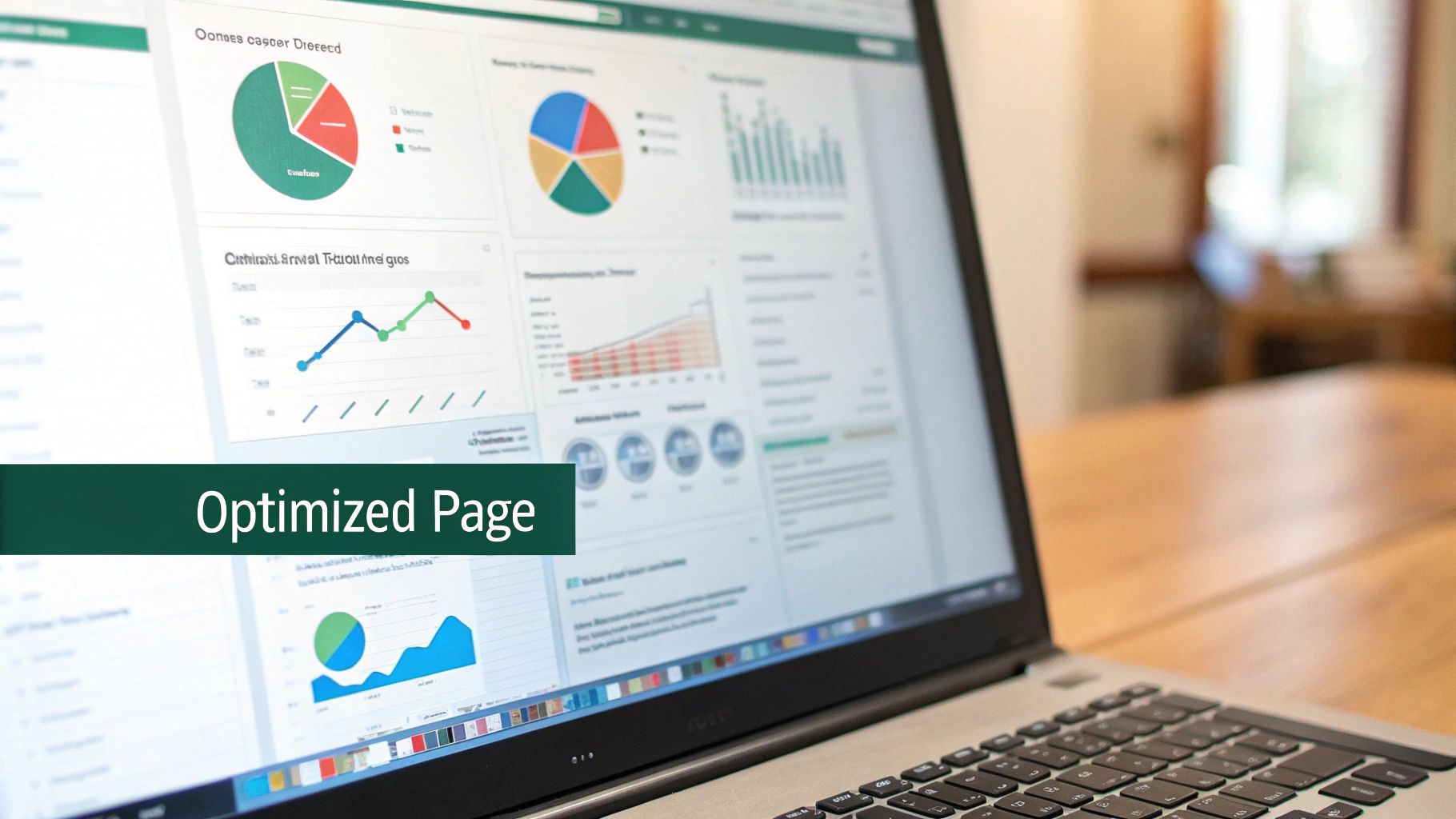
As shown, a well-optimized landing page aligns its message with the ad or link that brought the visitor there, creating a seamless and persuasive user experience that is fundamental to successful lead generation.
6. Account-Based Marketing (ABM)
Account-Based Marketing (ABM) flips the traditional lead generation funnel on its head. Instead of casting a wide net to capture as many leads as possible, ABM is a focused strategy where marketing and sales teams work together to target a specific set of high-value accounts. It involves creating hyper-personalized campaigns and content designed to resonate deeply with the key stakeholders at each target company.
This approach treats each target account as a market of one, ensuring that all outreach is highly relevant and tailored to their specific needs and pain points. By concentrating resources on the accounts most likely to convert, businesses can achieve higher engagement rates, larger deal sizes, and a more significant return on investment. This makes it one of the most effective B2B lead generation best practices for companies aiming to land enterprise-level clients.
How to Implement This Strategy
A successful ABM strategy requires deep alignment between sales and marketing and a commitment to personalization at scale. It's about quality over quantity, focusing intensely on the right prospects.
- Identify and Select High-Value Accounts: Begin by creating a detailed Ideal Customer Profile (ICP). Use this profile, along with firmographic and intent data, to build a list of target accounts that are the best fit for your solution.
- Align Sales and Marketing: Both teams must agree on the target accounts, messaging, and goals. This alignment is critical for a cohesive experience, as seen with platforms like 6sense and Demandbase that facilitate this collaboration.
- Create Account-Specific Content: Develop content and messaging that speaks directly to the challenges and goals of each target account. This could include personalized case studies, industry reports, or tailored sales presentations.
- Launch Coordinated Campaigns: Use a multi-channel approach to engage key stakeholders within each account. Companies like Terminus specialize in running orchestrated campaigns across display ads, social media, and email to surround the buying committee.
- Measure and Optimize: Track engagement across the entire account, not just individual leads. Measure metrics like account penetration, pipeline velocity, and deal size to gauge the effectiveness of your ABM efforts. For a deeper dive into similar B2B strategies, you can learn more about B2B lead generation on emailscout.io.
7. Webinars and Virtual Events
Webinars and virtual events are powerful, interactive platforms for lead generation that allow you to connect directly with a captive audience. By offering educational content, live Q&A sessions, or product demonstrations, you provide immense value in real-time. This format is ideal for showcasing deep expertise and building genuine relationships at scale.
This approach transforms lead generation from a passive activity into an engaging experience. Attendees register with their contact details in exchange for access to exclusive insights, positioning your brand as an industry authority. It's a highly effective strategy for attracting qualified leads who are actively interested in your subject matter and solutions, making it a cornerstone of modern lead generation best practices.
How to Implement This Strategy
A successful webinar requires more than just a presentation and a webcam. It demands strategic planning, promotion, and follow-up to maximize its lead-generating potential.
- Choose a High-Impact Topic: Focus on solving a specific, urgent problem for your target audience. Use customer feedback, keyword research, or sales team insights to identify pain points that will draw registrations.
- Promote Extensively: Begin promoting your event at least 2-3 weeks in advance across all channels. Use email marketing, social media posts, paid ads, and partner collaborations to build a strong list of registrants.
- Incorporate Interactive Elements: Keep your audience engaged throughout the event. Use live polls, Q&A sessions, and chat features to encourage participation and gather valuable feedback directly from potential customers.
- Follow Up with All Registrants: Your work isn't over when the webinar ends. Create a segmented follow-up sequence for both attendees and those who registered but couldn't make it, sharing the recording and relevant resources to continue the conversation.
- Offer an Exclusive Incentive: Encourage attendance and action by providing a special offer only for webinar participants. This could be a discount, an extended trial, or a free consultation.
The following video provides further insights into creating webinars that not only educate but also convert attendees into qualified leads.
By delivering tangible value and fostering direct interaction, webinars create a prime opportunity to guide interested prospects further down the sales funnel.
8. Referral and Partner Programs
Referral and partner programs are a powerful way to leverage your existing network of satisfied customers and strategic allies to drive growth. This approach transforms your happy customers, industry partners, and affiliates into a proactive, incentivized sales force. They generate leads through trusted, word-of-mouth recommendations, which are often more effective than traditional advertising.
This strategy works because it's built on trust. A lead that comes from a known and respected source is inherently warmer and more qualified. By rewarding both the referrer and the new customer, you create a self-sustaining cycle of advocacy. This makes referral marketing one of the most cost-effective and highest-converting lead generation best practices for scaling a business.
How to Implement This Strategy
A successful referral or partner program requires more than just asking for introductions. It needs a clear structure, compelling incentives, and robust tracking to be effective.
- Make Referring Effortless: The process should be incredibly simple. Provide referrers with a unique link or a simple form. Dropbox famously achieved 3900% growth by offering extra storage space through a one-click referral system.
- Offer Meaningful Incentives: Reward both the referrer and the new lead. This dual-sided incentive, like Airbnb's travel credit system, encourages participation from all parties.
- Equip Your Partners for Success: Provide your partners with a toolkit containing marketing materials, brand guidelines, and key messaging. HubSpot's partner program excels by offering agencies co-marketing resources and sales training.
- Track and Optimize Performance: Use dedicated software like ReferralCandy or Ambassador to monitor which channels and individuals are driving the most valuable leads. This data is crucial for refining your program.
- Celebrate Top Referrers: Publicly acknowledge and reward your most successful advocates. This recognition fosters loyalty and motivates others to increase their referral efforts, creating a virtuous cycle of lead generation.
9. Lead Scoring and Qualification
Not all leads are created equal, and lead scoring is the systematic process of separating high-potential prospects from the merely curious. This method involves assigning numerical values to leads based on their attributes and behaviors, such as demographic data, company information, and engagement with your brand. The higher the score, the more "sales-ready" the lead is considered to be.
This data-driven approach allows your sales and marketing teams to work in perfect alignment. Instead of wasting valuable time chasing every inquiry, your sales team can focus its energy exclusively on leads that demonstrate a strong interest and fit your ideal customer profile. This prioritization is a cornerstone of efficient lead generation best practices, ensuring resources are allocated where they will have the greatest impact and dramatically shortening the sales cycle.
How to Implement This Strategy
Effective lead scoring requires a collaborative effort between marketing and sales to define what makes a lead valuable. A well-designed model provides clarity and streamlines the handoff process.
- Define Your Criteria: Work with your sales team to identify the key demographic and behavioral indicators of a high-quality lead. This could include job title, company size, website pages visited, or content downloads.
- Assign Point Values: Assign positive scores for desirable actions (e.g., requesting a demo) and negative scores for disqualifying ones (e.g., a student email address). For instance, a "VP of Marketing" might get +15 points, while a visit to the pricing page gets +10.
- Set Scoring Thresholds: Establish clear score thresholds that define when a lead is considered Marketing Qualified (MQL) and ready to be passed to the sales team. This ensures a smooth and consistent handoff.
- Utilize Automation Platforms: Implement scoring within your CRM or marketing automation platform. Tools like HubSpot, Marketo, and Salesforce Pardot have robust, built-in lead scoring functionalities that can automate this entire process.
- Review and Refine Regularly: Lead scoring is not a "set it and forget it" task. Continuously analyze which leads convert to customers and adjust your scoring model to improve its accuracy over time.
10. Marketing Automation and CRM Integration
Marketing automation and CRM integration create a powerful, unified system for managing the entire customer lifecycle. By connecting your marketing automation platform (like HubSpot or ActiveCampaign) with your Customer Relationship Management (CRM) software (like Salesforce), you build a seamless bridge between your marketing and sales teams. This synergy ensures that every lead is captured, nurtured, and tracked efficiently, eliminating manual handoffs and data silos.
This integrated approach automates repetitive tasks such as lead scoring, email follow-ups, and data entry, freeing up your teams to focus on high-value activities. When a lead takes a specific action, like downloading a resource, the automation platform can nurture them with a personalized email sequence. Once they reach a certain engagement level, their data and history are seamlessly passed to the CRM for the sales team to take over, fully informed. This alignment is a cornerstone of modern lead generation best practices, turning scattered data into actionable intelligence.
How to Implement This Strategy
Successfully merging these two systems requires a strategic approach to ensure data flows correctly and workflows are effective from day one.
- Choose Compatible Platforms: Select marketing automation and CRM tools that offer robust, native integrations. Platforms like HubSpot offer an all-in-one solution, while others like Marketo and Salesforce are designed to work together seamlessly.
- Map the Customer Journey: Define the exact stages a lead moves through, from initial contact to becoming a customer. Use this map to build your automation workflows, specifying the triggers and actions for each stage.
- Ensure Data Hygiene: A successful integration relies on clean data. Implement a process for regular database maintenance and consider using tools for email address verification to keep your contact lists accurate and improve deliverability.
- Start with Simple Workflows: Begin with basic automation rules, such as a welcome email series for new subscribers or a notification to sales when a lead visits the pricing page. Add complexity as your team becomes more comfortable with the system.
- Train Both Teams: Ensure both marketing and sales departments understand how the integrated system works, what the data means, and what their respective roles are in the process. Proper training prevents misunderstandings and maximizes the ROI of your technology stack.
Lead Generation Best Practices Comparison
| Lead Generation Method | Implementation Complexity | Resource Requirements | Expected Outcomes | Ideal Use Cases | Key Advantages |
|---|---|---|---|---|---|
| Content Marketing and Lead Magnets | Medium to High (time-intensive content creation) | Significant content development and promotion | Builds brand authority; qualified leads; improves SEO | B2B/B2C with specific buyer personas needing education | Cost-effective; long-term asset; trust-building |
| Search Engine Optimization (SEO) | High (technical and ongoing) | SEO expertise; content creation | Sustainable organic traffic; high-intent lead capture | Businesses targeting organic search visibility | Low cost per lead over time; compound ROI |
| Social Media Lead Generation | Medium (platform-specific strategies) | Content creation; paid ads; engagement | Direct engagement; platform-specific conversions | B2B (LinkedIn), B2C (Facebook, Instagram) | Real-time interaction; advanced targeting |
| Email Marketing and Nurturing Campaigns | Medium (automation and content required) | Email platform and content teams | High ROI; personalized nurturing; measurable results | Businesses with existing lists or inbound leads | High ROI; automation at scale; direct communication |
| Landing Page Optimization | Medium (design and testing cycles) | Design, copywriting, analytics | Increased conversion rates; better campaign ROI | Campaign-specific traffic sources | Higher conversion; clear ROI tracking |
| Account-Based Marketing (ABM) | High (personalization and alignment) | Marketing and sales coordination | Higher deal sizes; shorter sales cycles | Enterprise B2B with high-value accounts | Focused resources; strong relationships |
| Webinars and Virtual Events | Medium to High (prep and tech setup) | Hosting platform; content experts | High engagement; valuable lead capture | Thought leadership; product demos; educational content | Direct interaction; scalable; repurposable content |
| Referral and Partner Programs | Medium (program setup and management) | Incentives and tracking tools | Higher quality leads; lower acquisition costs | Customer networks and partner channels | High conversion; self-sustaining growth |
| Lead Scoring and Qualification | High (data-driven model setup) | Analytics and CRM integration | Prioritized leads; improved sales efficiency | Teams with CRM data needing lead prioritization | Better sales focus; data-driven decisions |
| Marketing Automation and CRM Integration | High (complex setup and learning) | Software investment; training | Streamlined nurturing; improved productivity | Businesses scaling personalized communications | Scalable personalization; consistent follow-up |
From Strategy to Success: Activating Your Lead Generation Engine
You've just navigated ten of the most powerful and effective lead generation best practices available to modern businesses. From the magnetic pull of a well-crafted lead magnet and the long-term pipeline value of SEO, to the targeted precision of Account-Based Marketing and the engaging power of webinars, each strategy represents a vital gear in your growth machinery. However, the true path to a full pipeline and predictable revenue doesn't come from simply knowing these tactics; it comes from implementing them with intention, consistency, and a commitment to continuous improvement.
The journey from a passive approach to an active, thriving lead generation engine can feel daunting. The key is to avoid analysis paralysis and take decisive, focused action. Rather than attempting to overhaul your entire marketing and sales operation overnight, select one or two strategies from this list that align perfectly with your current business goals, available resources, and target audience.
Building Your Action Plan: The First 90 Days
To transform these concepts into tangible results, start by mapping out a clear plan. Your initial focus should be on building momentum and securing early wins that can justify further investment and team buy-in.
- For Businesses Needing Quick Wins: If your primary goal is immediate pipeline growth, prioritize strategies like optimizing your high-traffic landing pages or launching a targeted social media lead generation campaign. These initiatives can often produce measurable results in a shorter timeframe.
- For Businesses Focused on Long-Term, Sustainable Growth: If your focus is on building a foundational system, start with SEO and content marketing. While these efforts take longer to mature, they create an invaluable asset that generates high-quality, inbound leads for years to come.
- For Businesses Targeting High-Value Accounts: If your sales cycle is complex and involves multiple stakeholders, an Account-Based Marketing (ABM) pilot program is the logical starting point. Focus on a small, well-defined list of target accounts to refine your approach before scaling.
The Unifying Thread: Data-Driven Optimization
Regardless of the path you choose, a common theme weaves through all of these lead generation best practices: the critical importance of data and technology. Your success hinges on your ability to identify the right prospects, understand their needs, and engage them with personalized, relevant messaging at the perfect moment.
This is where the integration of your CRM, marketing automation platforms, and powerful data enrichment tools becomes non-negotiable. Implementing lead scoring helps your sales team focus their energy on the most qualified opportunities, preventing wasted effort on prospects who aren't ready to buy. Likewise, automating nurture sequences ensures that no lead falls through the cracks, keeping your brand top-of-mind until they are sales-ready.
Ultimately, mastering lead generation is not a one-time project; it is an ongoing discipline. It requires a mindset of perpetual testing, learning, and refinement. A/B test your landing page headlines, analyze your email open rates, track your webinar attendance, and constantly ask: "How can we make this process more efficient and more effective?" By embracing this iterative process and consistently applying the foundational strategies we've covered, you will move beyond sporadic lead acquisition and build a truly predictable, scalable system that fuels your business's growth for the long haul.
Ready to supercharge your outreach and ensure every email reaches a real, verified decision-maker? Stop wasting time on bounced emails and start building a high-quality lead list with EmailScout. Find and verify professional email addresses in seconds, directly integrating one of the most crucial lead generation best practices into your workflow. Try EmailScout for free today and connect with the people who matter most.
